April 05, 2010 – 02:07 am ET
.
It was another uneventful week but there have been a few subtle developments; some support has been established, Easter has been celebrated, April has been fooled and there has been a slight shift in leadership.
.
ETF % Change Comparison
.

Last week ended with SPY and DIA at new highs. This is positive apart from the fact that it is better to see the more economically sensitive ETFs leading the market higher. Instead we see SMH 2.41% off the high it reached 9 days ago and IYT 1.06% off the high it reached 14 days ago. This is only a subtle change and not cause for concern but it is different from what we have been seeing for the last two months where typically QQQQ, IWM and IYT have been leading. It appears as though the market is becoming more cautions which makes short term profit taking more likely.
.
What the % Comparison Table Tells Us:
By comparing the performance of the economically sensitive (SMH, QQQQ, IWM, IYT) and the comparatively stable ETFs (SPY and DIA) we can get an indication of the true market direction. The more sensitive areas of the market tend to be the first to initiate a trend change. For example if DIA and SPY sell off heavily while SMH and IWM (Russell 2000 small cap ETF) sell of mildly or continue moving to new highs then this would be very positive and vice versa.
The ‘Average Rank %’ is calculated by subtracting the % change for each ETF from the maximum % change and dividing it by the range for each period. 1-((MAX(% change all ETFs)-ETFs % Change)/(MAX(% change all ETFs)-MIN(% change all ETFs))) The readings for each period are then averaged. This reading is provided because if one ETF was significantly under/out performing the others then a plain high or low rank would not accurately reflect this.
.
![]()
.
A Look at the Charts
.
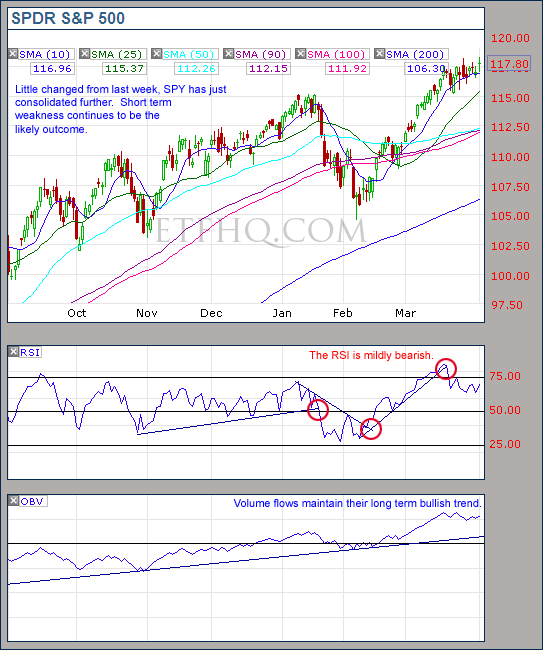
While SPY has had little momentum over the last three weeks it is impressive to see it inching higher bit by bit. This consolidation has ended the overbought situation and made it easier to start another bullish leg but profit taking is more likely over the short term.
.
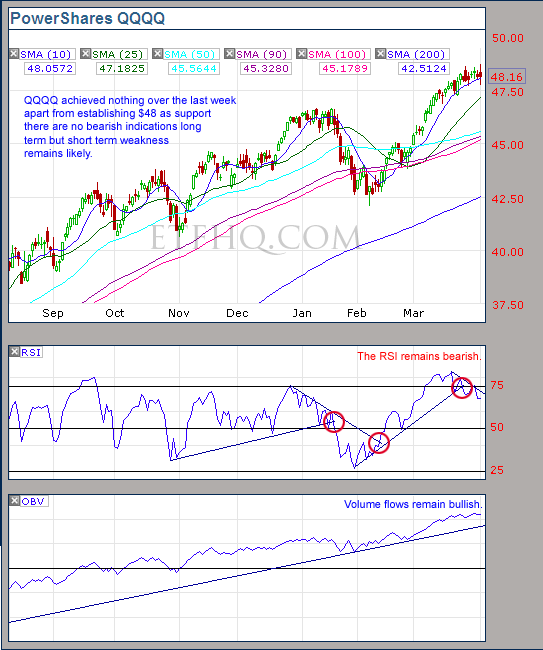
QQQQ could go either way from here but there is nothing to suggest problems with the longer term bullish trend.
.
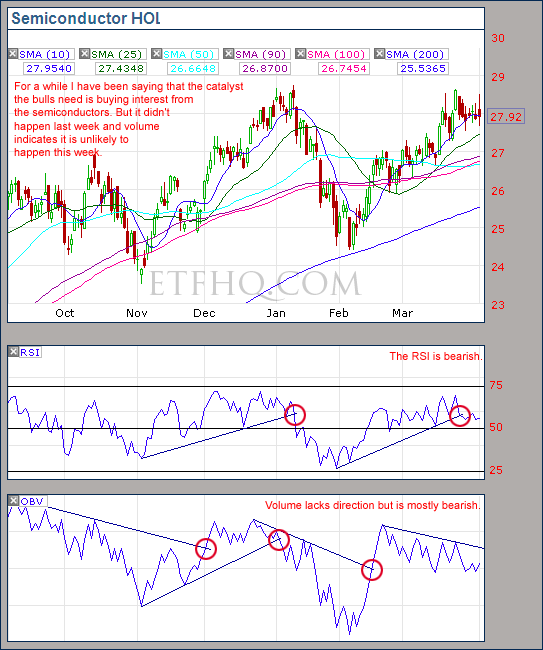
For the broad market to move higher from here in any meaningful way SMH will have to fuel the rally. Currently that looks unlikely.
.
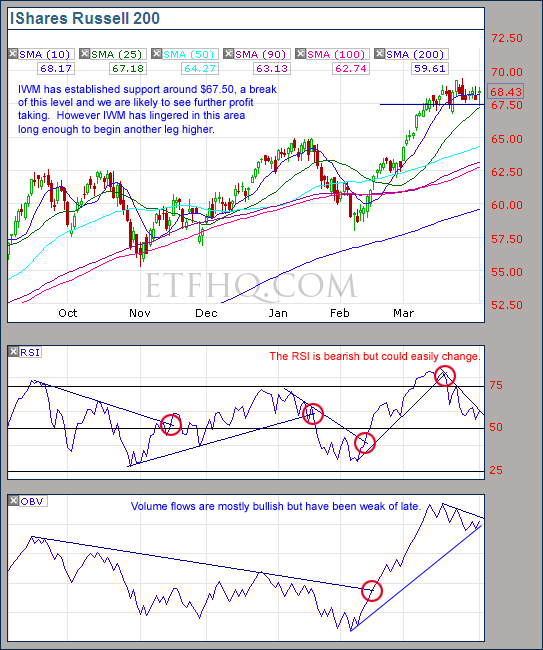
From IWM I will be looking for OBV to break out of its triangle accompanied by a loss of or maintenance of support @ $67.50. This will provide a good indication of market direction over the short term.
.
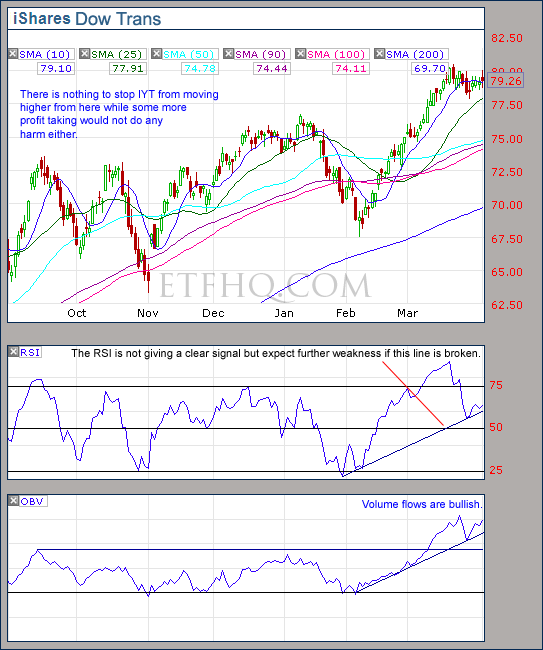
Volume from IYT is looking good and the slowdown over the last few weeks has been healthy.
.
![]()
.
OM3 Weekly Indicator
.

All signals remain bullish here.
.
How to read the OM3 indicator
The OM3 indicator as with most of our models primarily reads price action and volume. The strong/weak buy/sell signals are self-explanatory. ‘No Signal’ means that the component readings are in conflict and cancel each other out.
The alerts let you know if the cycle is speeding up or slowing down, so when you get at ‘Strong Buy, Bear Alert’ for instance it simply means that the criteria for a strong buy is in place but this weeks cycle reading is weaker (or more bearish) than last weeks reading (the same is true in reverse).
The number of weeks that a signal has been repeated is displayed. Historically a ‘Strong Buy’ signal has lasted for an average of 6 weeks and a maximum of 42 weeks, while a ‘Strong Sell’ has lasted for an average of 4 weeks and a maximum of 16.
This is an indicator not a mechanical trading model. It is useful to assist in analyzing the market but for the best results should be combined with commonsense and support/resistance levels etc.
.
![]()
.
TransDow & NasDow
.

The Dow Transportation Index remains dominant over the Dow and has advanced 6.24% over the last 34 days compared to just 5.83% for the Dow during that time. Conversely the Dow remains dominant over the NASDAQ, advancing 2.85% while dominant compared to just 1.47% for the NASDAQ.
.
What the TransDow Readings tell us:
The TransDow measures dominance between the DJ Transportation Index (DJTI) and the Dow Jones Industrial Average (DJIA). In a strong market the more economically sensitive Transportation Index should be dominant over the DJIA.
Historically the DJTI has been dominant over the Dow 45% of the time. The annualized rate of return from the DJTI during this period was 18.47% with the biggest loss for one trade sitting at -13.27%. The annualized return from the DJIA during the periods it was dominant over the DJTI was just 4.06% and the biggest loss for one trade was -16.13%. A 4% stop-loss is applied to all trades adjusting positions only at the end of the week.
What the NasDow Readings tell us:
The NasDow measures dominance between the NASDAQ and the DJIA. Using the same theory behind the Trans Dow; in a strong market the more economically sensitive NASDAQ should be dominant over the DJIA.
Historically the NASDAQ has been dominant over the DJIA 44% of the time. Taking only the trades when the NASDAQ is above its 40 week moving average the annualized rate of return was 25.47% with the biggest loss for one trade sitting at –8.59%. The annualized rate on the DJIA during the periods it was dominant over the NASDAQ is just 8.88% and the biggest loss for one trade was –12.28%. A 8% stop-loss is applied to all trades adjusting positions only at the end of the week.
.
![]()
.
LTMF 80 & Liquid Q
.

On Thursday Liquid Q closed the position in QQQQ for a 12.55% profit over 62 days. The signal remains open for LTMF 80.
.
Historical Stats:
.

.
How The LTMF 80 Works
LTMF stands for Long Term Market Forecaster. It reads volume flows relative to price action and looks for out performance of volume measured on a percentage basis over the prior 12 months. During a sustained rally the readings will reach high levels (near 100%) making it imposable for the volume reading to always outperform price so any reading above 80% will maintain the buy signal. This system has outperformed the market over the last 10 years but performance has been damaged by some nasty losses. It only produces buy signals and only for QQQQ.
How Liquid Q Works
Liquid Q completely ignores price action and instead measures the relative flow of money between a selection of economically sensitive and comparatively stable ares of the market. It looks for times when the smart money is confident and and can be seen by through volume investing heavily is more risky areas due to an expectation of expansion. This system has outperformed the market over the last 10 years and remained in cash through most of the major declines. It only produces buy signals and only for QQQQ. We will provide more performance details on the web site for these systems soon.
.
![]()
.
Summary
.
The consolidation over the last few weeks will make it easier for the market to start another leg higher. However for that to happen with any sort of enthusiasm then SMH will need to be driving the market higher. Judging by the current volume flows of the semiconductors that is unlikely. Over the longer term indications remain positive making bearish positions risky. Any profit taking should be seen as a buying opportunity.
.
Any disputes, questions, queries, comments or theories are most welcome in the comments section below.
.
Derry
And the Team @ ETF HQ
.
P.S If you get value from these newsletters then please spread the word, we grow primarily through word of mouth. Please direct people to ETFHQ.com to subscribe.
P.P.S Become a fan of ETFHQ on Facebook – HERE
.
![]()
.
The Devils Dictionary – G
.
GAAP – Generally Accepted Accounting Principles (as opposed to Specifically Accepted Accounting Principles which right there shouts out “Houston, we’ve got a problem!”) GAAP is intended to create consistency in financial reporting for pubic and private companies. Its vast inconsistencies with regulatory accounting and the IRS tax code is the primary source of investment banking revenues as bankers routinely attempt to exploit, circumvent or create small meaningless yet terribly complex discrepancies that result in arbitrage opportunities of epic proportions. Interestingly the U.S Government itself refuses to adopt GAAP standards and furthermore refuses to issue any useful financial reporting that would tell us how broke we really are. The main argument for refusing to adopt GAAP standards is that it would require extensive use of scientific notation due to the incomprehensibly large numbers involved. GAAP has taken on a new culturally significant meaning lately as in the GAAP between the truth and what is really going on.
Greater Fools – Wall Street’s ever expanding clientele.
Green Shoots – 1. The first signs of spring, often clobbered by summer’s heat and autumn’s rain. 2. A sign the economy is falling apart more slowly than previously thought. Related: Daisies, Pushing Up. See also Thinking, Wishful.
For Liquid Q, you state: “On Thursday Liquid Q closed the position in QQQQ for a 12.55% profit over 62 days. The signal remains open for LTMF 80.”. My question is if I had been subscribing at that time, would this newsletter be my first awareness that the position was closed or would I have known on Thursday or Friday?
Thanks
Hi E H Harris, great question. We should start providing these updates before the market closes via our Facebook page. Currently I just put them in the weekly newsletter.
Cheers
Derry